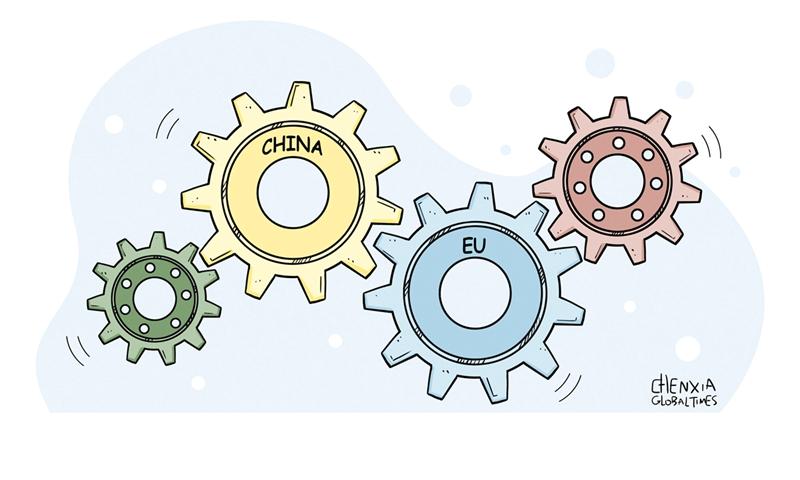Hype over China’s ‘trade diversion’ in European market is misplaced

Illustration: Chen Xia/GT
There seem to be some voices surfacing these days, fearing that, as a result of the upheaval caused by US tariff policies, Chinese goods may flood into the European market in large quantities. However, these worries overlook the long-standing mutually beneficial nature of China-Europe trade, essentially representing unnecessary noise in normal trade cooperation.
The US tariffs on China "could lead to a hazardous scenario for European countries: the dumping of artificially cheap products that could undermine local industries," The New York Times reported recently.
"We will also be watching closely what indirect effects these tariffs could have, because we cannot absorb global overcapacity nor will we accept dumping on our market," European Commission President Ursula von der Leyen said in a speech earlier this month.
Her remarks and some media's hype reflect a misplaced anxiety about the so-called "trade diversion" of Chinese exports. Yet, such fears are largely unfounded and fundamentally disconnected from the reality of China-Europe trade relations.
The so-called "trade diversion" risk is largely a pseudoproposition. Those who bring it up may have the ulterior motive of driving a wedge between China and Europe so as to hinder further deepening of cooperation at a time when both parties are in particular need of strengthening collaboration.
The ineffectiveness of the US tariff war has become increasingly evident, as the global community, including China and Europe, has seen through its true nature: a unilateral attempt to disrupt global trade order under the pretext of addressing trade "imbalances." This is not a matter of "Chinese overproduction," but a deliberate sabotage of normal trade networks by the US.
China-Europe trade has always been mutually beneficial. Chinese goods entering the European market are based on market demand and economic laws. According to a recent analysis released by the Bruegel Institute, since the EU and China have quite distinct comparative advantages, there is little overlap of exports, with only 21 of 94 product categories above the 10 percent threshold. Most represent very small trade flows, with the three most exposed categories (umbrellas, wickerwork and toys) each representing less than 0.05 percent of EU exports.
For the EU, the most concerning category is electrical machinery, equipment and parts. However, a large part of Chinese exports in this category of products to the US is composed of smartphones and lithium-ion batteries. Since the EU produces virtually no smartphones, Chinese exports primarily meet European market demand rather than replacing EU industries and products. In battery manufacturing, Chinese lithium-battery exports support the EU's new-energy vehicle industry and risk to the EU overall seems limited.
Data further illustrate that the impact of so-called "trade diversion" on Europe is limited. From 2018 to 2024, China's share of exports to the US decreased by 4.5 percent, while the increase in its share of exports to the EU remained moderate. This further underscores China's diversified market strategies.
Moreover, China's status as the world's second-largest consumer market since 2018 means it has little motivation to dump goods in Europe. Domestic demand has become the primary driver of China's economic growth. Chinese companies are increasingly focused on technological innovation and quality improvement, not price dumping, to compete in global markets.
It is important to note that China does not shy away from trade issues with the EU, but these are entirely different from a tariff war. Both sides share extensive common interests and cooperation opportunities, and both are committed to resolving trade disputes through dialogue and cooperation rather than unilateral protectionism. Through constructive dialogue and cooperation, China and the EU can better understand each other's concerns and find mutually beneficial solutions, safeguarding the stability and healthy development of their trade relations.
In the current landscape, Europe is advised to focus on more constructive opportunities in China. China's strategy of expanding domestic demand and boosting consumption opens up vast market opportunities for European quality products and services.
China's vigorous promotion of services sector liberalization in areas like healthcare and cultural entertainment provides new development prospects for European companies. The EU should recognize the positive impacts of Chinese policies and take the opportunity to seize market share amid the trade upheaval caused by the US tariff hikes.
Fundamentally, the real distortion in global trade stems not from China but from escalating US unilateralism. In response to the situation, it is crucial for the EU to focus on pragmatic engagement and join China in opposing protectionism, thus transforming challenges into opportunities.